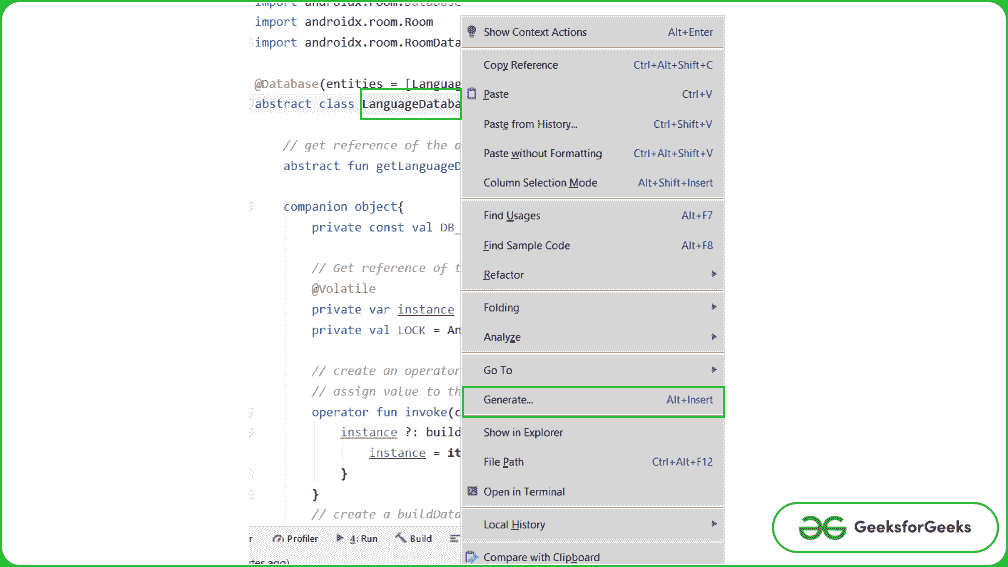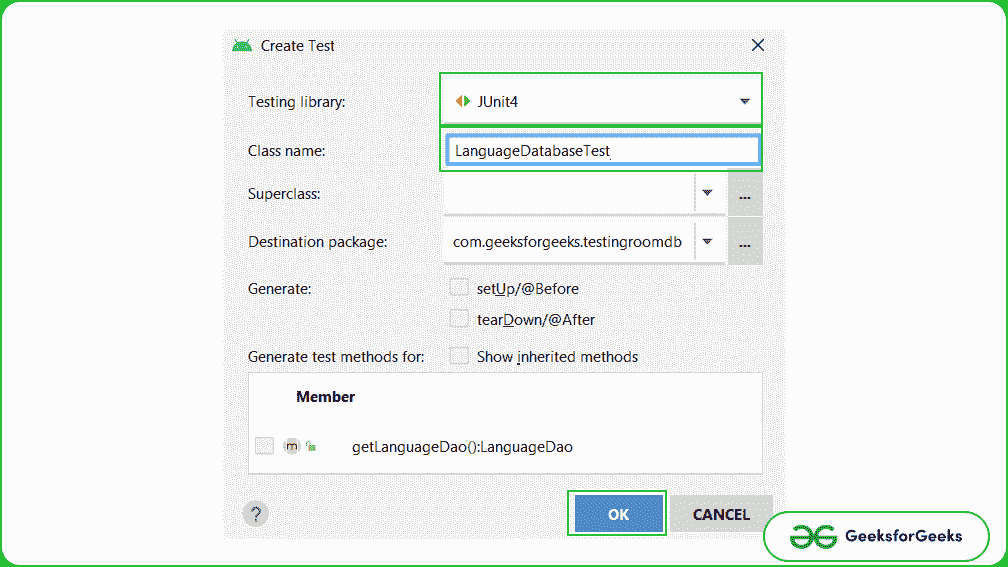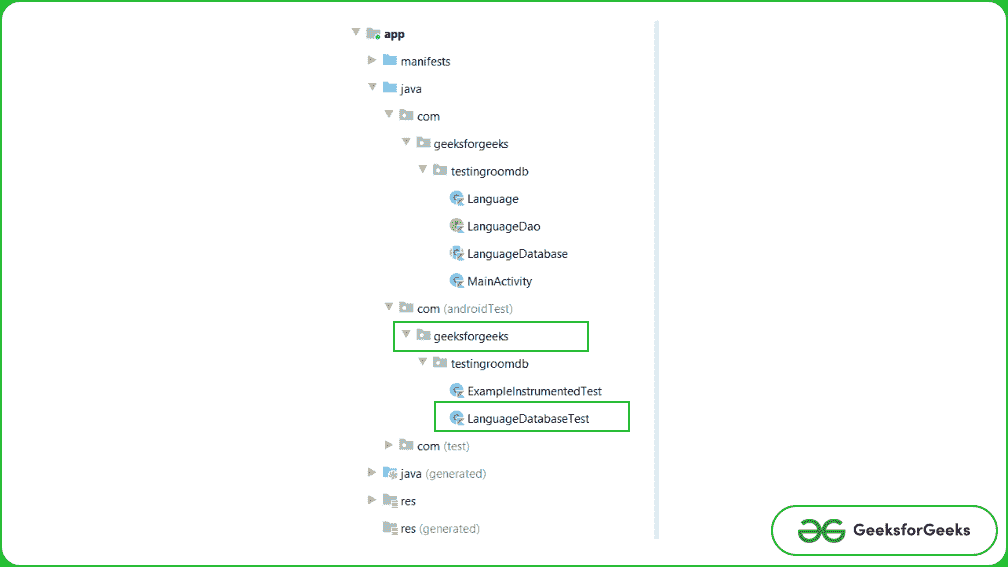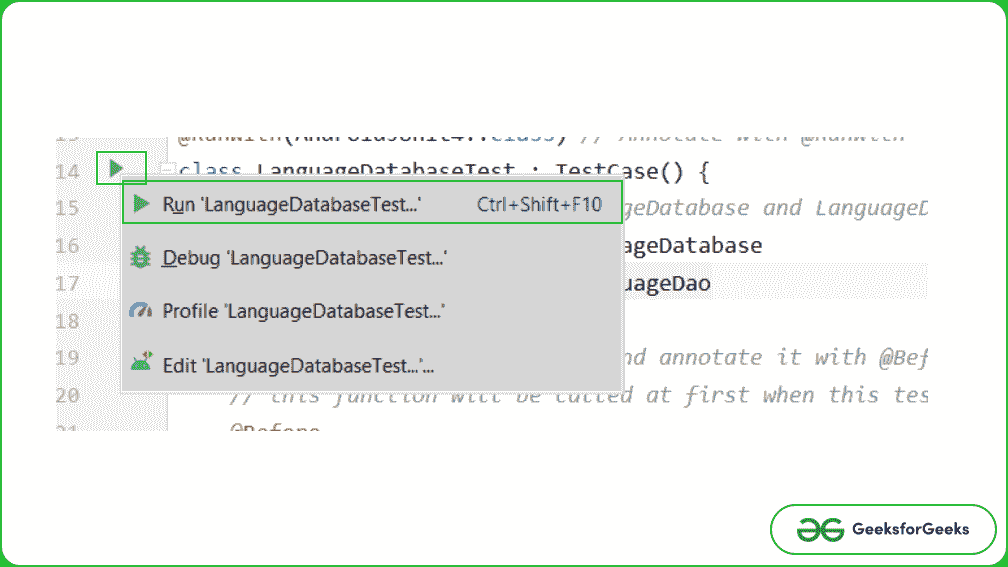使用 JUnit 的安卓测试室数据库
原文:https://www . geesforgeks . org/testing-room-database-in-Android-use-JUnit/
在本文中,我们将在 android 中测试房间数据库。这里我们使用 JUnit 来测试我们的代码。JUnit 是 Java 应用程序的“单元测试”框架,默认情况下已经包含在 android studio 中。它是单元测试和用户界面测试的自动化框架。包含 @Test 、 @Before 、 @After 等注解。这里我们将只使用 @Test 注释来保持文章的通俗易懂。注意,我们将使用 Kotlin 语言来实现这个项目。
分步实施
第一步:创建新项目
要在安卓工作室创建新项目,请参考如何在安卓工作室创建/启动新项目。注意选择科特林作为编程语言。
第二步:添加依赖关系
在 build.gradle(项目)中,在 dependencies 下添加以下代码。它包含房间数据库、科罗廷、JUnit、真理和其他的依赖关系。
实现" org . jet brains . kot linx:kot linx-coroutines-Android:1 . 4 . 1 "
实现“androidx . room:room-runtime:2 . 2 . 6”
实现“androidx . legacy:legacy-support-v4:1 . 0 . 0”
kapt " androidx . room:room-编译器:2.2.6 "
实现“androidx.room:room-ktx:2.2.6”
测试实现“androidx . arch . core:core-testing:2 . 1 . 0”
测试实施“androidx . room:room-testing:2 . 2 . 6”
testimplementation“JUnit:JUnit:4 . 13 . 2”
testImplementation " com . Google . truth:truth:1 . 1 . 2 "
测试实施" org . jetbrains . kot linx:kot linx-corroutes-test:1 . 3 . 4 "
testImplementation ' org . robo electric:robo electric:4 . 5 . 1 '
andidstimulation " andidx . test . ext:JUnit-ktx:1 . 1 . 2 "
androidTestImplementation“androidx . test . espresso:espresso-core:3 . 3 . 0”
androidTestImplementation " com . Google . truth:truth:1 . 1 . 2 "
androidTestImplementation " androidx . arch . core:core-testing:2 . 1 . 0 "
androidTestImplementation " androidx . test:规则:1.3.0 "
androidTestImplementation " androidx . test:runner:1 . 3 . 0 "
andiddstruction " andidx . test:core-ktx:1 . 3 . 0 "
在编写我们的测试之前,让我们首先创建房间数据库
第三步:新建模型类“language . kt”
新建一个类“ Language.kt ”,用 @Entity 标注,传递表名。
我的锅
import androidx.room.Entity
import androidx.room.PrimaryKey
@Entity(tableName = "language")
data class Language(
val languageName : String="",
val experience : String=""
) {
@PrimaryKey(autoGenerate = true)
var id : Long=0
}
第四步:创建 dao 界面
新建一个类“ LanguageDao.kt ”,用 @Dao 标注。添加注释是为了更好地理解代码。
我的锅
import androidx.room.Dao
import androidx.room.Insert
import androidx.room.Query
@Dao
interface LanguageDao {
// Write two functions one for adding language to the database
// and another for retrieving all the items present in room db.
@Insert
suspend fun addLanguage(language: Language)
@Query("SELECT * FROM language ORDER BY languageName DESC")
suspend fun getAllLanguages(): List<Language>
}
步骤 5:创建数据库类
创建一个新的抽象类“ LanguageDatabase.kt ”,并用 @Database 进行标注。下面是 LanguageDatabase.kt 的代码,为了更好的理解,增加了类注释。
我的锅
import android.content.Context
import androidx.room.Database
import androidx.room.Room
import androidx.room.RoomDatabase
@Database(entities = [Language::class] , version = 1)
abstract class LanguageDatabase : RoomDatabase() {
// get reference of the dao interface that we just created
abstract fun getLanguageDao() : LanguageDao
companion object{
private const val DB_NAME = "Language-Database.db"
// Get reference of the LanguageDatabase and assign it null value
@Volatile
private var instance : LanguageDatabase? = null
private val LOCK = Any()
// create an operator fun which has context as a parameter
// assign value to the instance variable
operator fun invoke(context: Context) = instance ?: synchronized(LOCK){
instance ?: buildDatabase(context).also{
instance = it
}
}
// create a buildDatabase function assign the required values
private fun buildDatabase(context: Context) = Room.databaseBuilder(
context.applicationContext,
LanguageDatabase::class.java,
DB_NAME
).fallbackToDestructiveMigration().build()
}
}
第 6 步:创建测试类
要创建语言数据库的测试类,请右键单击语言数据库,然后单击生成,然后选择测试。将打开一个对话框,从对话框中选择测试库为 JUnit4 并保留类名为默认的语言数据库测试,点击确定。之后,会打开另一个对话框选择目标目录,选择有的目录..app\src\AndoidTest\。因为我们的测试类需要来自应用程序的上下文。下面是指导你创建测试类的截图。





第 7 步:使用语言数据库 Test.kt 类
转到语言数据库 Test.kt 文件,编写以下代码。代码中添加了注释,以更详细地理解代码。
我的锅
import android.content.Context
import androidx.room.Room
import androidx.test.core.app.ApplicationProvider
import androidx.test.ext.junit.runners.AndroidJUnit4
import com.google.common.truth.Truth.assertThat
import junit.framework.TestCase
import kotlinx.coroutines.runBlocking
import org.junit.*
import org.junit.runner.RunWith
@RunWith(AndroidJUnit4::class) // Annotate with @RunWith
class LanguageDatabaseTest : TestCase() {
// get reference to the LanguageDatabase and LanguageDao class
private lateinit var db: LanguageDatabase
private lateinit var dao: LanguageDao
// Override function setUp() and annotate it with @Before
// this function will be called at first when this test class is called
@Before
public override fun setUp() {
// get context -- since this is an instrumental test it requires
// context from the running application
val context = ApplicationProvider.getApplicationContext<Context>()
// initialize the db and dao variable
db = Room.inMemoryDatabaseBuilder(context, LanguageDatabase::class.java).build()
dao = db.getLanguageDao()
}
// Override function closeDb() and annotate it with @After
// this function will be called at last when this test class is called
@After
fun closeDb() {
db.close()
}
// create a test function and annotate it with @Test
// here we are first adding an item to the db and then checking if that item
// is present in the db -- if the item is present then our test cases pass
@Test
fun writeAndReadLanguage() = runBlocking {
val language = Language("Java", "2 Years")
dao.addLanguage(language)
val languages = dao.getAllLanguages()
assertThat(languages.contains(language)).isTrue()
}
}
第 8 步:运行测试
要运行测试用例,点击类名附近的小运行图标,然后选择运行语言数据库测试。如果所有的测试用例都通过了,你会在运行控制台得到一个绿色的勾号。就我们而言,所有测试都通过了。


Github 回购 这里 。

